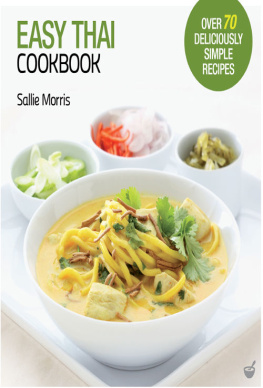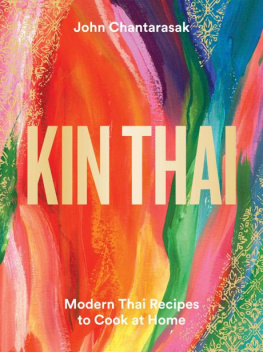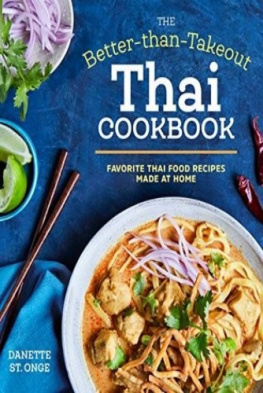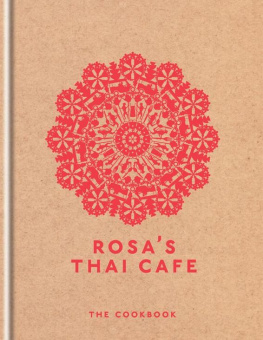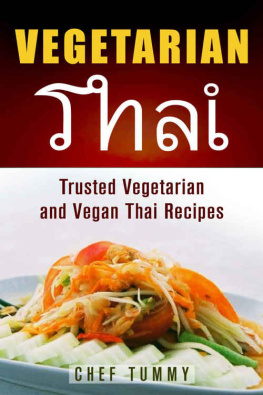C ONTENTS

T HAILAND, FOR CENTURIES A STOP-OFF FOR TRADERS, HAS SKILFULLY ASSIMILATED INFLUENCES FROM OTHER COUNTRIES INTO ITS OWN DISTINCTIVE CUISINE WITHOUT COMPROMISING LOCAL CULTURE AND RITUALS.

Despite acting as a trade conduit throughout its history, Thailand, unlike many other Asian nations, has never been ruled by a European power. Mystical and exotic, Siam, as Thailand was once known, managed simultaneously to charm, manipulate and resist her European visitors. Closer neighbours were not so easily rebuffed and Thailand was periodically invaded, most notably by Burma. Despite these incursions, Thailands remarkably stable religious (Buddhist) and cultural history, coupled with an abundance of locally grown food, is reflected in its historic cuisine.
M ost Thai men spend at least three months of their young lives as a monk and, since monks are fed by everyone in the community as a mark of respect, so food and religion are bound together. The basic tenets of Thai cuisine are ancient in origin and they were upheld for centuries by the royal kitchens while being supplemented by many outside influences. Even though they are worlds apart in terms of wealth, the underlying ingredients and recipes used, as well as the styles of cooking, were, and still are, not much different between court and country. Presentation, with intricate artistry employed, and, to a certain extent, the superior quality of the ingredients available to the court, were what elevated the cuisine of the royal kitchens above that of the common people. The palaces put much effort into the teaching of culinary skills and crafts in order to maintain their proud reputations.
Geographically, culinary ideas have seeped into Thailand through the borders with Malaysia, Laos, Cambodia and Burma. China, who had a far-reaching influence on the entire region, has also made her mark on Thai cuisine. As would be expected, influences are strongest nearest the borders. The dishes found along the Mekong River have close affiliations to Laos, Cambodia and Vietnam. Around Chiang Mai there are Burmese-style curries and soups, and close to Malaysia, Muslim recipes such as massaman are common.
The most significant addition to Thai cuisine came not from Asia but from South America, via Europe. In the sixteenth century the Portuguese introduced what is now one of the hallmarks of the cuisine, the chilli. Thai cuisine, like that of other cultures that accepted the chilli so readily, had long included an element of heat by way of fresh green peppercorns, dried white peppercorns and galangal. As well, foreign vegetables and fruit have been cultivated for the last few centuries: tomatoes, eggplants (aubergines), asparagus, carrots (known as orange long turnips), corn and snow peas (mangetout) are common.
Thai food is, on the whole, made to be shared. Everything on the table is an accompaniment to rice, the most important component of the meal. Generally the rice is served with a curry, a fish dish, a stir-fry, a salad, a soup and vegetables. All the food is served at once. Soups come in a large bowl and are eaten with the meal, not before it. Meals begin when the host says kin khao or eat rice. The food is not necessarily eaten piping hot.
Thai people eat with a spoon and fork, the fork being used to push food onto the spoon or to pick up pieces of meat or sliced fruit. Chopsticks are only used with noodles, and sticky rice and its accompaniments are eaten using the right hand. When eating in Thailand there are further subtle areas of etiquette to be observed. Platters of food are left on the table, and not passed around, as stretching is not considered rude and someone on the other side of the table will always be happy to spoon things onto your plate. You should take only a couple of spoonfuls of each dish at a time.

The north-east region of Thailand is known as Isaan and the food of the region is identified by the same name. Most of the area is a high plateau divided by the Phu Phan mountains. Divided from the rest of Thailand by more mountains, Laos and Cambodia, just over the border, have had a strong culinary influence, with much of the cuisines overlapping. The Mekong River flows along the border with both countries and has been the main means of trade for centuries.
North-eastern Thailand was one of the first areas in Asia to grow rice. Rice is cultivated over much of the plateau but rainfall is unreliable, making the yield patchy. Sticky rice is preferred in the countryside and long-grain rice in the cities. As much of the area is poorer than the rest of the country, food reflects this. Rice is a staple and dishes that are served with it are small in quantity but pungent in flavour. Unfermented fish sauce and chillies are the main seasonings. Pickled and preserved foods are a symptom of an unreliable food supply and also add more flavour to a diet of rice in this form than their fresh state.
Kai yang or kai ping (grilled chicken) is found all over the area. The chicken is rubbed with garlic, fish sauce, coriander (cilantro) root or lemon grass and black pepper, then flattened and pinned on a bamboo skewer before being barbecued over coals and served with a chilli dipping sauce. Chicken is also made into laap, a minced meat salad with lime juice, fish sauce, lemon grass, chillies or chilli powder and khao khua pon (roasted rice). Duck, fish and buffalo are also used to make laap, and grilled strips of beef are used for similar salads.
Som tam, a green papaya salad with chillies, peanuts, cherry tomatoes and dried shrimp, is a popular snack. Individual portions are pounded together by hand and eaten with sticky rice. Soups are hot and sour style (tom) or spicy style (sukii). The very south of the region has some coconut milk in soups.
Insects and frogs are popular, and red ants are used as a souring agent in some dishes. Fish are freshwater, the Mekong River being famous for the giant catfish caught from it, mainly in the months of April and May.
Northern Thailand, which is the area bordered by Burma to the west and Laos to the east, has always had a strong regional identity that is distinctively different from south and central Thailand. Hill tribes farm the hillsides, growing corn and rice, and families work as collectives, helping one another during planting and harvest time. The cooler climate of the hills means that many types of European fruit grow well, so peaches, apples and strawberries are found growing alongside lychees. Vegetables such as asparagus, snow peas (mangetout) and corn are also cultivated.






